The story behind that picture: "An interview with Thorsten von Overgaard in CONNOISSEURS"
By: Fey-ing Wink/Connoisseurs (this is a copy of the article that appeared in the printed magazine and online)
“If you look around at people with a camera you see in the street, or have a look at the most popular subjects on the internet, you can easily tell that photography is one of the biggest interests on the planet. We all love to create, and sometimes we also like the intriguing technology of photography, which is basically painting with light.” - Internationally Danish Feature Writer & Leica Photographer Thorsten Overgaard

In a nutshell, what are the differences between general photography and photojournalism?
Yes, there is a difference. Generally speaking - and let that be a warning to anybody seeking a career as a photographer - photojournalism seems to be most popular with people who seek photography as an interesting career and thus take an education to become a photographer, eventually end up illustrating stories tailored for newspapers. This might sound a bit negative, and perhaps it is, because the majority of photojournalists end up as angry men in a photo pit shooting pictures for others. But some rise above the randomness of the one having to illustrate the news stories, there're notable photographers such as Terakopian in London and Jan Grarup in Denmark who do really nice work and enjoy what they are doing.
The definition of a photographer is one who takes photographs. If one does that and some like it and will use his photographs, his is a photographer. It doesn't take an education but a good eye, enthusiasm and the will to find a way of making a living from it. So that is the real difference between the happy photographer and the unhappy one: If you are taking the photos that you enjoy taking you will be happy, but fulfilling a job as one who takes home images will make you unhappy. The more you wanted to create something, the less happy you will be with not creating your own images.
That said, quite a lot of people love to take photographs. It goes like that for many who see something and take a photo of it with a phone camera or a pocket camera. Often, it's snapshots (of what just happened) and ironically our mind already made a perfect recording of it hence we don't need to make one more with a camera. But if you wanted to share it, you have to take a photograph so you can show others.
Moving up from the snapshot to real photography, you see something and then think how that may become aesthetic or presented in a way nobody else thought of. Often good photos are of things, places and situations we all know but never saw the way a good photographer managed to show it to us.
So when you utilized the mechanical abilities of a camera to store the image, and couple it with the unique ability of the mind or soul to see what something could become - you may have art!
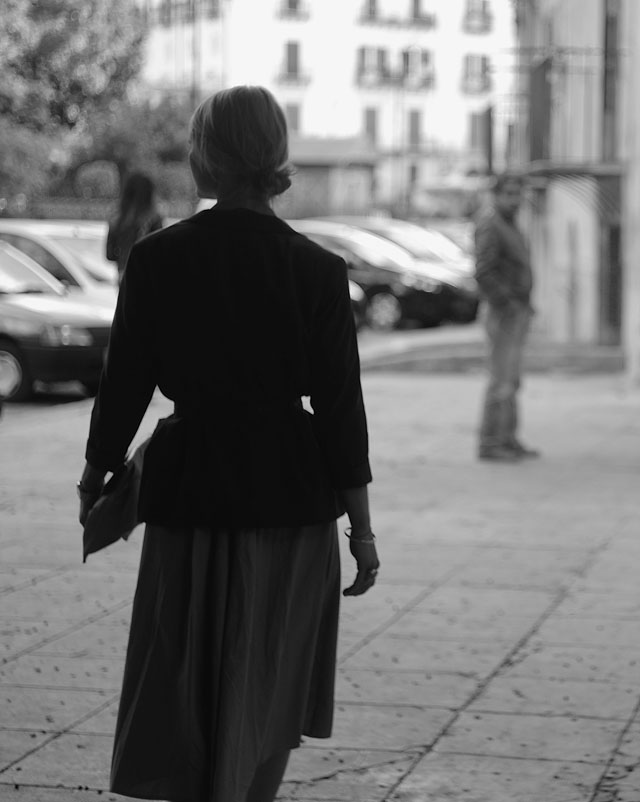
DIOR LADY by Thorsten Overgaard (from "The Salzburg Collection")
Dealing with different (sometimes difficult) people, criticism and distractions are a part of a photojournalists’ routine. How do you stay in the zone (stay positive, motivated, impartial) and stay focused to produce strong and artistic works?
It helps a lot in photography to have a purpose. If you had to have a photo of some people demonstrating, you get the courage, the eye and the efficiency the purpose requires. Because you basically know from the beginning, what the picture you need to get must contain, or hold emotions off, for it to communicate.
In all photography, you always see the image first. It could be either a split-second before you get it or days or months before. It can be some light or other that inspires you, or an interesting person, or the fact that something is happening. But you see the possibility to create an image hence you see the image first. Only training will make the vision clearer and make you able to play with the elements and get a great shot even if the conditions turn out to be very different from what you anticipated.
If one realizes ones own purpose (also as an amateur), it helps. The purpose may be to document or preserve our time and the way things look, or to document one’s kids growing up. Or the purpose may be to show others the beauty of things, or perhaps even a simple purpose as: "Photography is something I am good at.”
But the purpose makes you productive, so you got to have one. And it's a very interesting thing for any photographer to sit down and think for a moment, "What are the messages of my typical images?", "What do I communicate?" and "What seems to be my purpose(s) for my photography?" Because often you can't help but taking photos, so there is a reason. And the better you understand the reason why you do it, the better you will be able to do it, with higher quality and make your images more pure and effective in communicating exactly what you want them to.
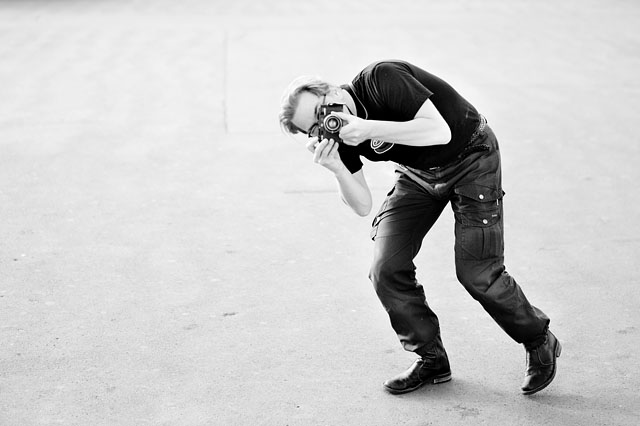
Thorsten Overgaard in Paris. Photo by Birgit Krippner
I have a rule, that I will only photograph people when it can do something good for them. As a professional you get to shoot a lot, including photos that are not profitable for the persons in them. So, it's a matter of personal integrity that you select only the ones that will do something good.
This makes you a better photographer in others eyes, and it also gives you a decency that comes across when you work. People can feel your intention when you point a camera towards them, the same way you can feel if the receptionist will be giving you a nice room in the hotel or doesn't really care if you sleep on the floor.
Some may think photojournalism is about breaking the rules of decency and show the world "How bad it really is". I couldn't disagree more. The photo that changed the Vietnam war, the historic "Napalm Girl" shot in 1972 by Huynh Cong Ut depicting the girl running on the road after the Americans bombed with napalm is an example of a photo that wasn't harmful to the person in it, yet carried a strong story that had an impact that changed the worlds opinion on a war in a distant country. Huynt Cong Ut took a series of photos, and as a photographer he had to choose which one to use. And the one we choose has to be the one that relays the story and message without invalidating people unnecessarily.
To stay in the same category, the Vietnam photograph of a war prisoner being shot in the head in open daylight on the street ... even that is presenting the killer with decency. Good pictures always do; I can't recall a single great photo that degrades the person in it without degrading the photo itself at the same time.
The pictures showing royal families or celebrities in their worst or 'funny' situations are products of hunters with a camera, working for indecent medias. They basically have nothing to do with journalism or photography.
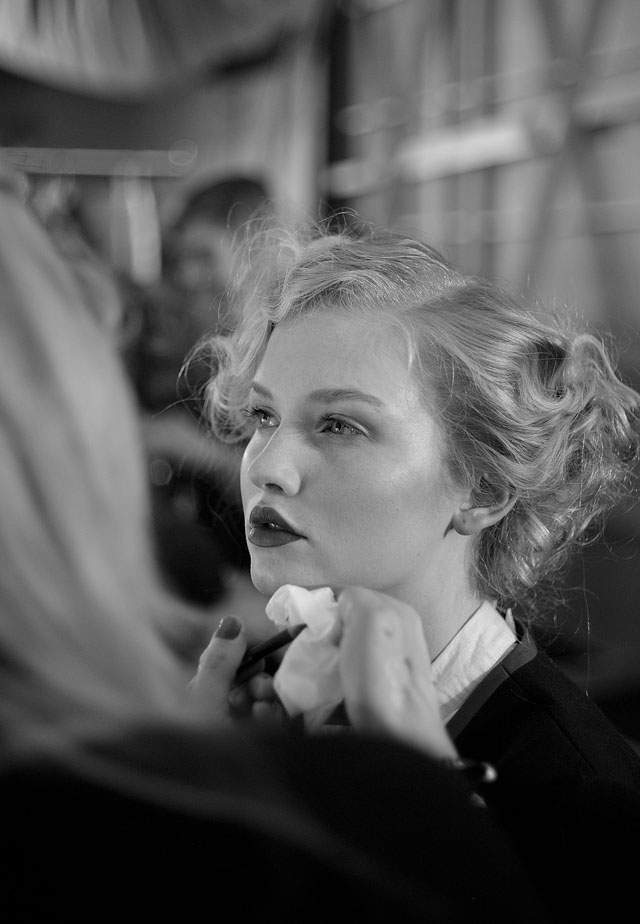
MAKE UP by Thorsten Overgaard (from "The Salzburg Collection")
From the stories you did and your website, you seem to be equally curious and critical over many different subjects and topics. Would you not get distracted? How do you manage time/effort in order to complete each project?
Digital photography helps a lot to finalize things right after you have done them, and I try to finish every project the same day. Editing your images the same day keeps them fresh and makes the editing part of the creative process. It makes you realize what worked well, and what didn't. The next day you start afresh with new experiences and finish with richer pictures later.
I disagree with the idea that an artist should stay unorganized and follow the flow. The great artists in music and film I know are all very organized, and I am too. When I edit pictures, I do them all, I add all information to the image files while I remember names and places, and save editions in a set of sizes for any possible use on my website, by picture agencies and clients. That also means that when I want to do a story on my website or for my newsletter, I take images from my image library that are thus ready to use. I don't have to revisit the film rolls or the raw files. Everything is ready for use right after I shot it.
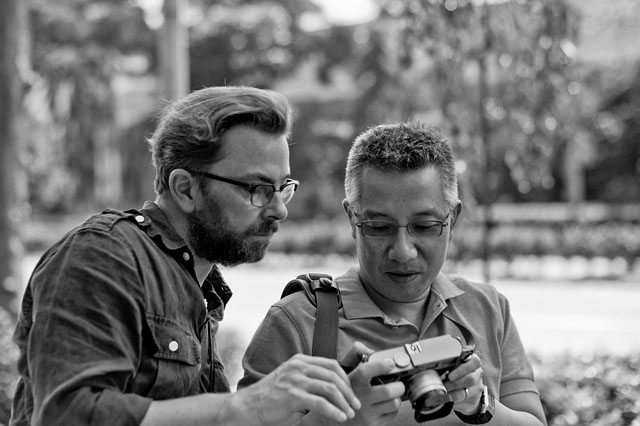
Singapore workshop, photo by Ron Yeoh
My website is an intriguing thing because it has always been a spare time passion that has grown to be visited by 650,000 people a year. I genuinely relax and reflect whenever I write something for my website, and I like to help and share advice, so everything I do reflects this. The fact that it has a big audience is just a bonus for me and, I guess for others too.
Do you fuel your passion or the passion fuels you? And how does this help you in your work? (for example, you seemed to be able to work around projects with intentionally limited equipment, and yet produce strongly emotional and inspiring images, not to mention after thoughts that you share on your website)
The passion comes from results. So one has to have in mind that one must produce pictures. It's not an examination of your ability to take enough good pictures when you take photos. Nobody should care how many photos you take, only how many good ones you show. I usually reverse people’s workflow when they do my seminars. Many people take photos and think "I didn't get any good ones today" and store them on their hard drive. And if and when they try to edit them, they start by deleting the bad ones instead of making final pictures out of the good ones!
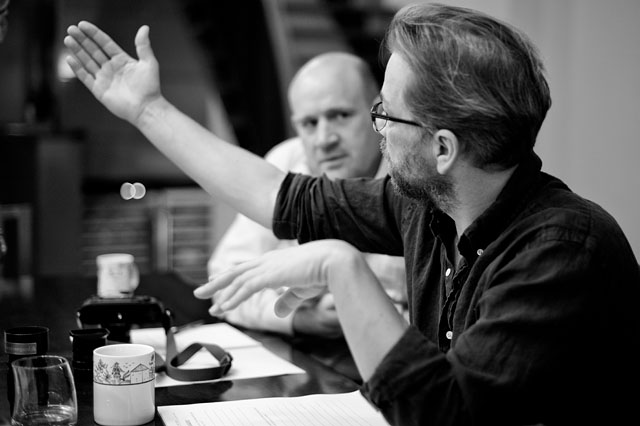
Workshop in Singapore. Photo by Frank Stelzer
So, I teach people to only look for images that are worth finishing and presenting, not the bad ones. Forget those. The only thing that counts and will impress others, are the good ones. And, never throw anything away, never delete anything! It's a waste of time and energy trying to decide if something is bad enough to delete. Bad energy! Focus solely on making good images. If you do one good image a week that is 52 in a year and several thousands in a lifetime. That's pretty good.
And sometimes less is more. You may select 10 or 20 photos of somebody to save to your archive. But you only send him one or five of the best ones. That's how you maintain a reputation as a good photographer. It builds self-confidence, client relations and fuels your passion.
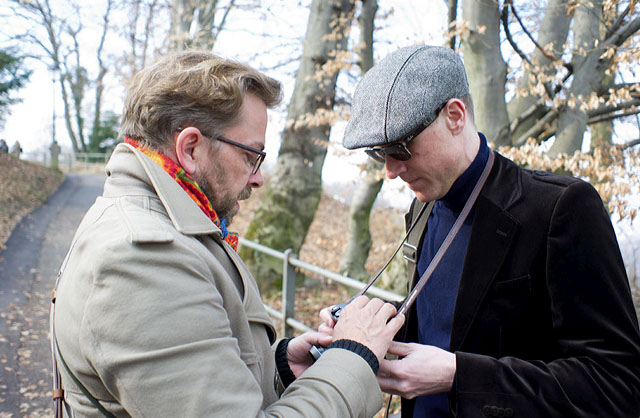
Thorsten Overgaard and Matthias Frei at the Overgaard workshop in Salzburg, Austria. Photo by Andrea Unterberger
I also think that it is important to make your own choices. I shoot what I want, with the equipment I want to use and have developed a style, which is what my clients want. So this is a lucky self-supporting choice because I started out with what I felt was fun doing and got an audience who thought it was unique and what they needed. Many start out with equipment they are assigned to use, doing assignments others decide them to do, and eventually have others decide which images will be used. That is a sure route to burn out. You can't be creative and have others decide what you should like. You’ve got to develop your own style and your own specialty, which you will get known for. Not when you grow up or become rich, but from the beginning where you don't have five kids and two cars to support. And it goes remarkably fast to build a style and a clientele, I would say you can start getting food within weeks from your photography and have a real style that generates your income in a couple of years.
I'm very much in control of my photography. Basically doing what you like to do does fuel your enthusiasm for it.
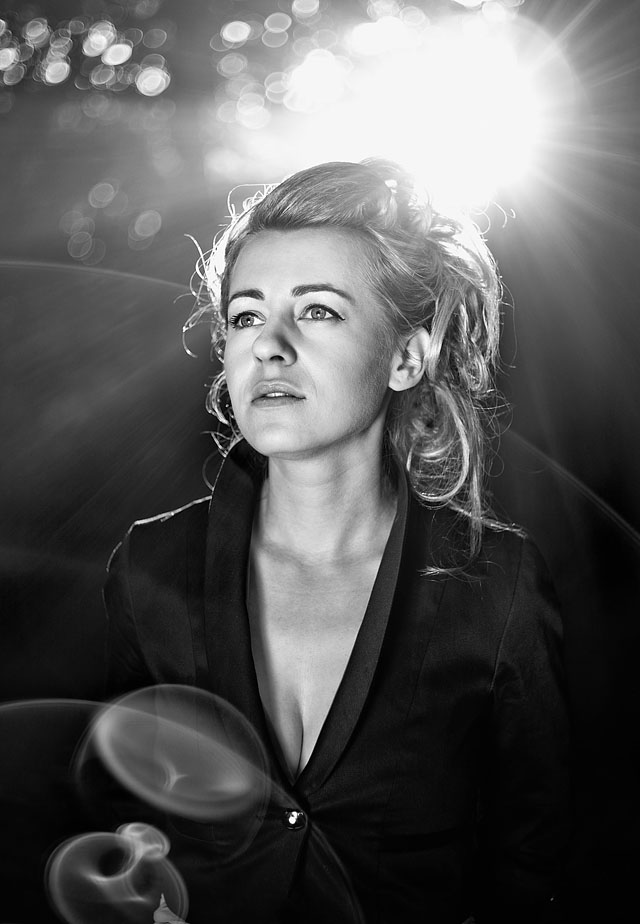
Singer-Songwriter Catherine Kubillus by Thorsten Overgaard (from "The Salzburg Collection")
Have you decided to replace your Leica R series with a full range of M series already? Can you tell us more about these two very different breeds of instruments? (from the aspect of intuitiveness, image quality and suitable type of photography)
I still keep my R equipment but rarely use it. I have circa ten Leica R’s and Leica M film cameras. I don't part with (as I am sure there will come a digital film one day). But I learned after a few months with the Leica M9, (after it came out in September 2009) that Leica M9 images has the same quality as Leica R dSLR images. I played around more with the Leica M9 and got some interesting photos.

Working with Lightroom in Singapore. Photo by Alan Tan
With dSLR, you tend to plan the photo and then get that. With the Leica M9 rangefinder you see the picture possibility and it's more a matter of trusting your instincts than actually ensuring a given result. In a way, with Leica M9 your confidence is in yourself, whereas with dSLR it is often in the equipment. This is why, some photographers have so much equipment that they are prepared for everything. It's just about light, so if you can control light as you can with the Leica M9 and the Leica lenses, then you can do anything. But it takes a few months experiencing it, to see it and believe in it.
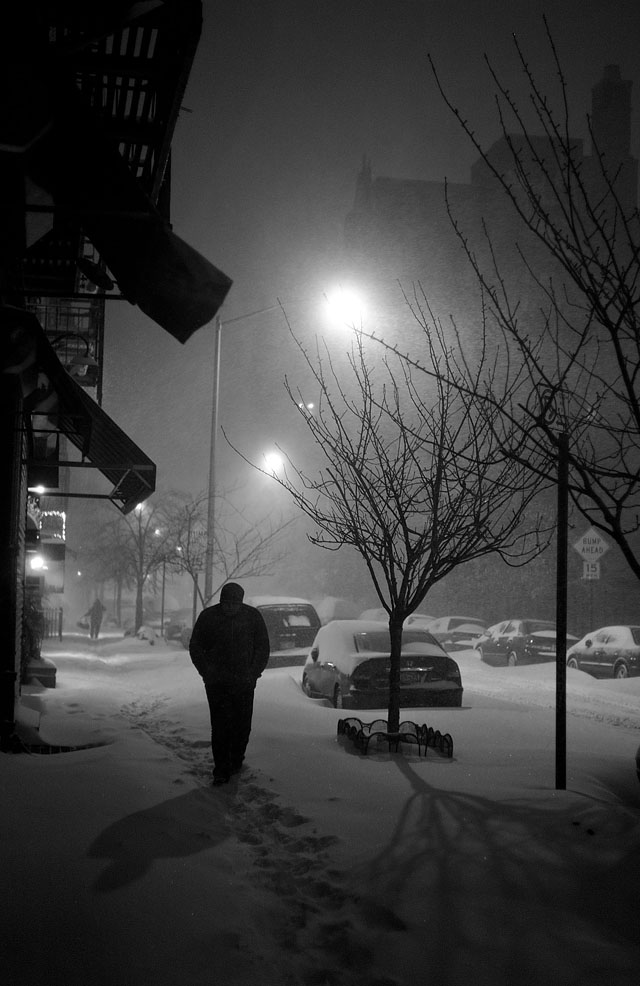
By Thorsten Overgaard (from "The Salzburg Collection")
I travel quite a bit, with a Leica M9 around the neck, a few lenses, a light meter and a reflector. Sometimes an extra M9 in the bag too. Life is so much easier when you walk through airport security without a 25 kg trolley full of dSLR equipment.
I have also used the Leica S2. It is a perfect camera. The shooting style is very much like a dSLR and as long as the light conditions are good, the result is perfect, detailed, 3D and accurate colours without much work in Lightroom. I might consider a Leica S3 as a replacement for the Leica R9 dSLR, but I'm not sure if I really need it. But the Leica S is, as I see it, the replacement for the Leica R, just much better.
Visit Thorsten's website at www.overgaard.dk for further info and seminar schedules.
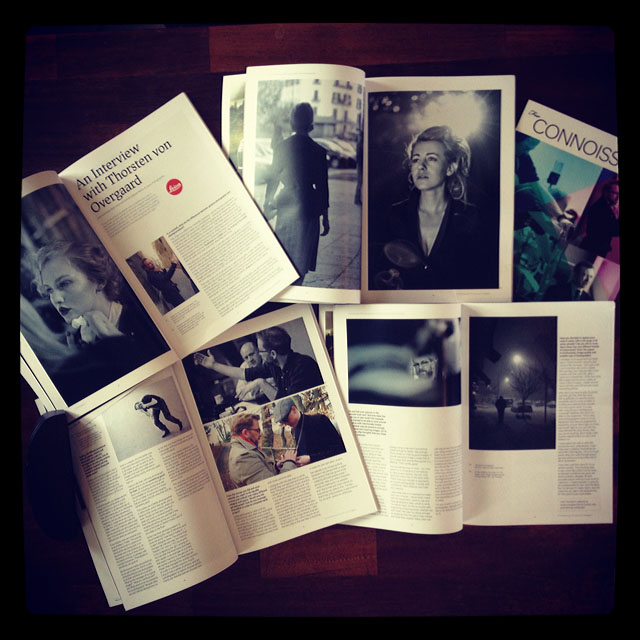

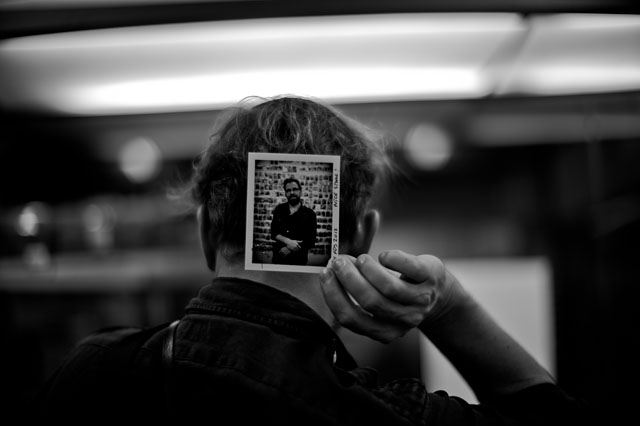
Thorsten Overgaard in Singapore by Ron Yeoh

Thorsten Overgaard workshop in Salzburg, Austria. Photo by Andrea Unterberger
![]()
